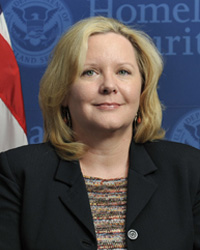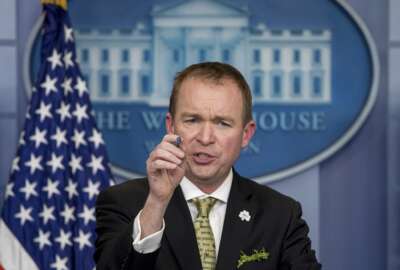

The Office of Management and Budget is expected to release a new memo later this week, which will describe an initial review of existing requirements and reporting...
Agencies will soon see new guidance from the Office of Management and Budget on reducing low-value, burdensome activities.
OMB is planning to release a memo Thursday, which will describe an initial review of existing requirements and reporting burdens that the administration believes agencies can scale back, said Dustin Brown, deputy assistant director for management at OMB.
Brown described the forthcoming announcement as a “down-payment” on the administration’s initial efforts to cut back on burdensome agency activities and reporting requirements.
More work on this priority, which is one of four major focus areas in the President’s Management Agenda, will continue.
“I know each of the CXO councils and communities are in the process of identifying things that we could streamline, things that we could maybe make less frequent, things we could stop doing in order to help free up resources and capacity to focus on those higher-value and more mission-focused activities,” Brown said during a June 13 panel discussion at ACT-IAC’s “Acquisition Excellence” conference in Washington.
The fiscal 2018 “skinny” budget first outlined, in general terms, the four basic tenets of the President’s Management Agenda.
“I know that was early and pretty broad, but I do think it sent an important signal that management will be a key focal point of this administration’s efforts to make government more effective and efficient,” Brown said.
Besides reducing burdensome activities, the administration and the President’s Management Council will focus on improving mission delivery, particularly citizen-facing services.
Improving the effectiveness and cost of mission-support functions, such as financial management, shared services and category management is another major priority.
Margie Graves, deputy federal chief information officer at OMB, said the administration needs to expand the shared service marketplace.
“We know that we need shared services,” she said. “We need them badly. We need them delivered effectively. They’re a key part of our strategy for modernizing IT, but ultimately, we need to send a demand signal to the commercial marketplace. We just don’t have enough capacity within the federal government, even supported by commercial entities, to deliver on that promise.”
Finally, tracking performance and holding individuals accountable is the fourth main priority.
Agencies will see some familiar guidelines on measuring performance, Brown said.
“This administration has agreed to mainly use the statutory framework that was developed back in 2010 with the [Government Performance and Results Act] GPRA Modernization Act, that will have a set of cross-agency priority goals, agency specific priority goals and then [a] broad set of strategic goals and objectives that will be included as part of each agency’s strategic plan,” he said. “Having some continuity on that standpoint is actually a pretty important thing, so that we aren’t constantly reinventing how we track these but actually leveraging the framework that Congress and the executive branch have agreed is the structure that we can use and measure our progress against them.”
OMB sees the president’s executive order on reorganizing government and restructuring the federal workforce as an overarching umbrella for several other initiatives and efforts to streamline.
“We’re trying to connect the dots from other [executive orders] into that equation, including the cyber EO and others that are coming down the pike, so that people connect those dots and you see the same repeated strategies in every document with perhaps a little bit of a different lens,” Graves said.
In a recent President’s Management Council meeting, Graves said agencies started discussing what activities they can do together.
“NASA, the National Science Foundation and Energy Department were looking at how … [to] deliver science? How do we deliver the activities of laboratories? How do we deliver some of mission areas? What comes right behind that is how do we finance that effectively and how do we put acquisition strategies in place that would actually support that happening?” Graves said . “When you think about the lab of the future and how these entities might work together in a new reformed manner, acquisition always plays into that.”
The Trump administration received more than 100,000 comments from the public on ways to make government more efficient and responsive to citizens’ needs. The formal public comment period ended June 12.
OMB has been collecting those comments and organizing them by agency. The first version had a spreadsheet of about 5,000 columns, but OMB has since arranged the comments into a more manageable format for the agencies, Brown said.
Each agency has been receiving that feedback in batches. Agency leaders are looking at the comments, and many are holding working group meetings to discuss reform ideas.
“Some people are reporting it’s the first time they’ve gotten certain [senior executives] who actually work in somewhat related areas are yielding good ideas,” he said. “They’re excited about finding mechanisms to make sure there’s an ongoing way for that to happen, so it’s not just about a plan or a report. This really does try to transform the way that we operate as a government to have a more systemic way of getting feedback from the front lines, employees, managers, outside groups.”
Agencies’ draft reform plans are due to OMB June 30.
OMB is also developing a list of more than 100 ideas and themes that cut across multiple agencies. The administration is beginning to whittle those ideas down now, so it can begin to incorporate them into the fiscal 2019 budget process.
Meanwhile, the Office of Federal Procurement Policy is also helping agency leaders think about how they’re going to approach the reform effort.
When talking to agency acquisition shops, Joanie Newhart, associate administrator of acquisition workforce programs at OFPP, said she’s focusing on organization, processes and people.
“Do we have right people with the right skills in the right place? The leaders are looking at their whole organizations,” she said. “How many 1105 [contracting officers] do I have? How many GS-7s? How many GS-13s? Is that the right mix? They haven’t really had the opportunity to look at it before now. I know maybe they’ve wanted to, but there hasn’t been the appetite. Now is the perfect opportunity to do it. We’re seeing that they’re doing it, and they’re sharing ideas.”
Copyright © 2025 Federal News Network. All rights reserved. This website is not intended for users located within the European Economic Area.
Nicole Ogrysko is a reporter for Federal News Network focusing on the federal workforce and federal pay and benefits.
Follow @nogryskoWFED



